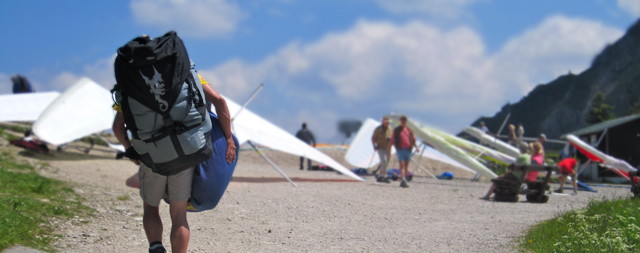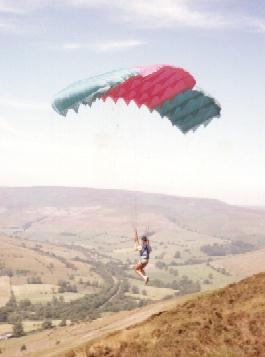
Paragliding is the most recent and fastest growing form of free flight. All one needs to fly is a foldable glider and a harness to sit in. It is a unique kind of soarable aircraft because it is highly portable – the entire kit can be packed into a large rucksack and carried on the pilot’s back, making it considerably easier to access a number of soaring sites, and expanding the options for landing sites from which one can return.
Paragliding is by over 200,000 pilots around the world. It is most popular in Europe, particularly Switzerland, Germany, France, and Italy which collectively had over 125,000 pilots in 2004. In the United States, there are about 5,000 pilots (as of 2011). Although the sport is increasing in popularity. A paraglider is launched from a hillside or can be towed with a winch. It is kept aloft by a “ram-air” design that keeps it inflated as it moves forward, making the shape of the glider like an airplane wing that generates lift. Steering is accomplished by two vertical “riser lines” attached to trailing edge of the glider on both sides.
Figures: USHPA, Wikipedia.org
History and Origins
 The origin of paragliding has roots in the sport of parachuting. In the early 1960’s, American parachutist Pierre Lemoigne was successful in cutting slots in the round parachute canopy to allow for air to flow through the canopy. This had a dramatic effect on the lift to drag ratio and allowed for the pilot to steer the chute in a predictable manner.
The origin of paragliding has roots in the sport of parachuting. In the early 1960’s, American parachutist Pierre Lemoigne was successful in cutting slots in the round parachute canopy to allow for air to flow through the canopy. This had a dramatic effect on the lift to drag ratio and allowed for the pilot to steer the chute in a predictable manner.
In 1962, Walter Newmark of England took note of Lemoigne’s design and modified it so the chute could be towed aloft. During the 60’s, parascending become a popular sport amongst the English. Newmark was responsible for the creation of the British Association of Parascending in the early 1970’s.
In 1964, Domina Jalbert of Florida invented a square canopy called the Ram Air Para Foil. The Ram Air worked by allowing air to pass through the double surface glider allowing for better maneuverability and increased lift. Walter Newmark soon adopted this canopy for his parascending activities.
Not until the 1970’s did the sport take off. The popularity of paragliding arose when pilots in the French town of Mieussy successfully launched the wing by running down the hillsides of the Alps. Andre Bohn and Gerard Bosson were mostly responsible for developing the sport into how it is today. Bosson introduced paragliding at the 1979 World Hang Gliding Championships. It was not long until paragliding schools were opening up around the world.
Source: open-site.org
Related Sports
The boom in paragliding popularity quickly gave rise to related sports. These newer sports are also growing, and are developing more specialized equipment and gear:
Powered paragliding is the flying of paragliders with a small engine attached.
Speed riding is the separate sport of flying paragliders of reduced size. These wings have increased speed, though they are not normally capable of soaring flight. The sport involves taking off on skis or on foot and swooping rapidly down in close proximity to the slope, even periodically touching it if skis are used.
Source: wikipedia.org